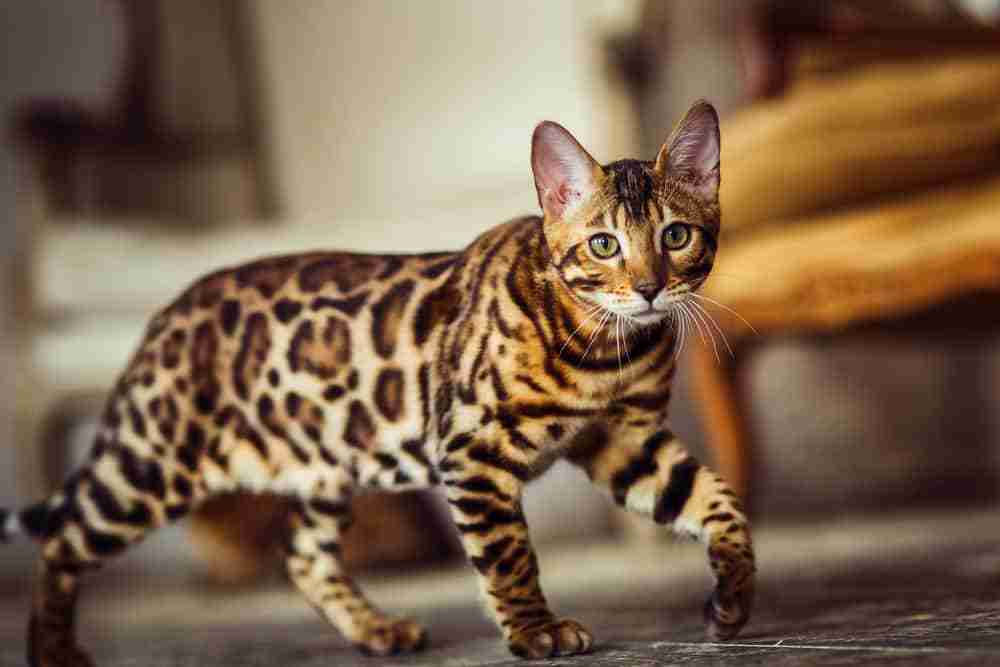If you’ve been on the lookout for an active and smart cat breed, you’ve no doubt come across the Bengal cat breed. With its vivid coat patterns and advanced intelligence, this hybrid wild cat is a widely known and well-loved breed all around the globe.
Not only are these cats known for being playful and affectionate, but they’re also a great choice for most households, be they filled with children, adults, or even seniors.
These hybrid cats are expensive and require a higher level of care and maintenance compared to a standard domestic cat to have a long and healthy life. They are widely recognized as having litter box issues. Are you up to the task of loving and raising such an energetic breed of cat?
Here’s our comprehensive guide to help you decide.
An Overview of the Bengal Cat
| Height | 13 – 16 in |
| Weight | 8 – 15lbs. |
| Lifespan | 10 – 17 years |
| Origin | United States |
| Temperament | Affectionate, playful, and relentlessly energetic |
| Activity Level | Active (Very!) |
| Compatibility | High compatibility with kids and other pets |
| Coat | Short |
| Shedding | Medium |
| Colors | Orange, White, Black, Chocolate, Charcoal or gray/silver |
| Patterns | Spotted, marbled |
| Allergy-friendly? | No |
| Vocalness | Medium to Loud |
| Prey Drive | High |
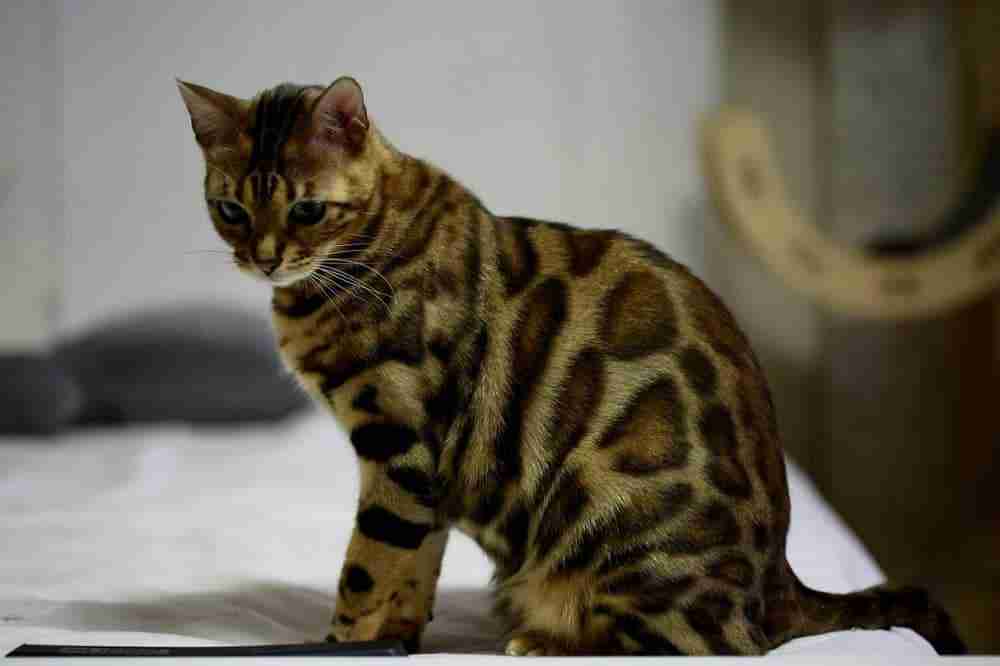
Characteristics
Bengal cats are known for their wild appearance, and inside, they also have a wild streak. They have sweet, affectionate, and talkative personalities, almost to a fault (so if you don’t like vocal cats, this might not be the right breed for you!).
That is not to say that your cat will meow excessively, but if they’re hungry or bored, expect them to be vocal.
Furthermore, they’re sociable: so, if you’re concerned about whether your new cat will get along with children or other pets (both cats and dogs) in the house, don’t be: they will fit right in.
That said, it’s essential they are socialized from an early age, exposing them to pets and household members alike. Otherwise, you might face a bit of a challenge. You might also want to reconsider your choice to get one of these cats if you have small toddlers who might annoy them.
Bengal cats are also an active, curious and intelligent breed, so they love playing with toys and being treated to games for mental engagement. You’ll have a fun time training your cat to do tricks and can even walk them on a leash if you wish.
They are well known for having a mischievous streak and love messing about in water. If you can’t give your cat access to a splash pool then you are going to have an unhappy cat!
History
Attempting to cross domestic cats with Asian leopard cats to create unique cats was a practice already in place by the early 19th century. However, the Bengal breed wasn’t fully formed until the 20th century was underway.
Jean Mill, a renowned conservationist, and a breeder was the first to cross a domestic cat with an Asian leopard cat, and by 1996, the Bengal was a recognized breed.
Personality
The personality of these hybrid cats is nothing short of a treat. They’re curious, active, intelligent, mischievous, and talkative, as well as lovers of attention and entertainment.
With that said, if you’re a first-time cat owner, we don’t recommend getting one of these cats for yourself unless you can ensure that you’ll be able to give them the time and attention that they need. They are not like standard cats – expect wild behavior!
Although Bengals are characterized mainly by their energy levels and enthusiasm, they do have a soft side that makes them love being lap cats. So don’t shy away from giving them love and affection.
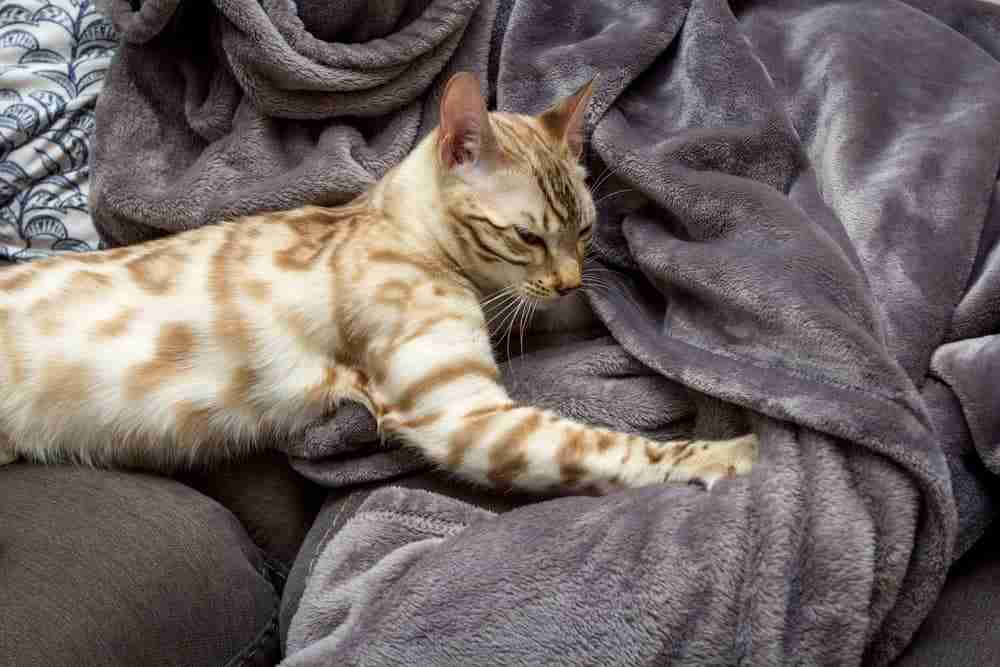
Appearance
Anyone who loves jungle cats will instantly recognize the wild lineage of the Bengal. With a marbled or spotted coat usually in orange, brown, chocolate, or silver, these cats look like a regal prince/princess of the jungle, the likes of an ocelot or leopard.
In fact, did you know that the Bengal is the only breed to have rosette markings? They have muscular and lengthy bodies with short, dense coats with super-soft fur that is minimally shedding; truly a sight to behold.
Size
This stealthy, active, and lithe cat is medium to large-size, with a bodyweight usually between 8 and 15 pounds. Their legs are pretty long, which enables them to jump or climb to great heights.
Colors
These cats are typically orange/brown, white, charcoal, chocolate, or gray/silver, with uniquely beautiful marbled and spotted coats. White Bengals are called Snow Bengal Cats. They tend to have yellow, green, brown, or orange eyes.
Grooming
It’s quite easy caring for their coat as it’s short. At most, all you have to do is brush the cat’s coat once a week. They don’t have to be bathed on a regular basis, either, but if you do need to wash them, you won’t have a hard time since they love water.
You should also avoid bathing your Bengal too frequently (more than once every 3-4 weeks), as this can lead to skin conditions like dermatitis.
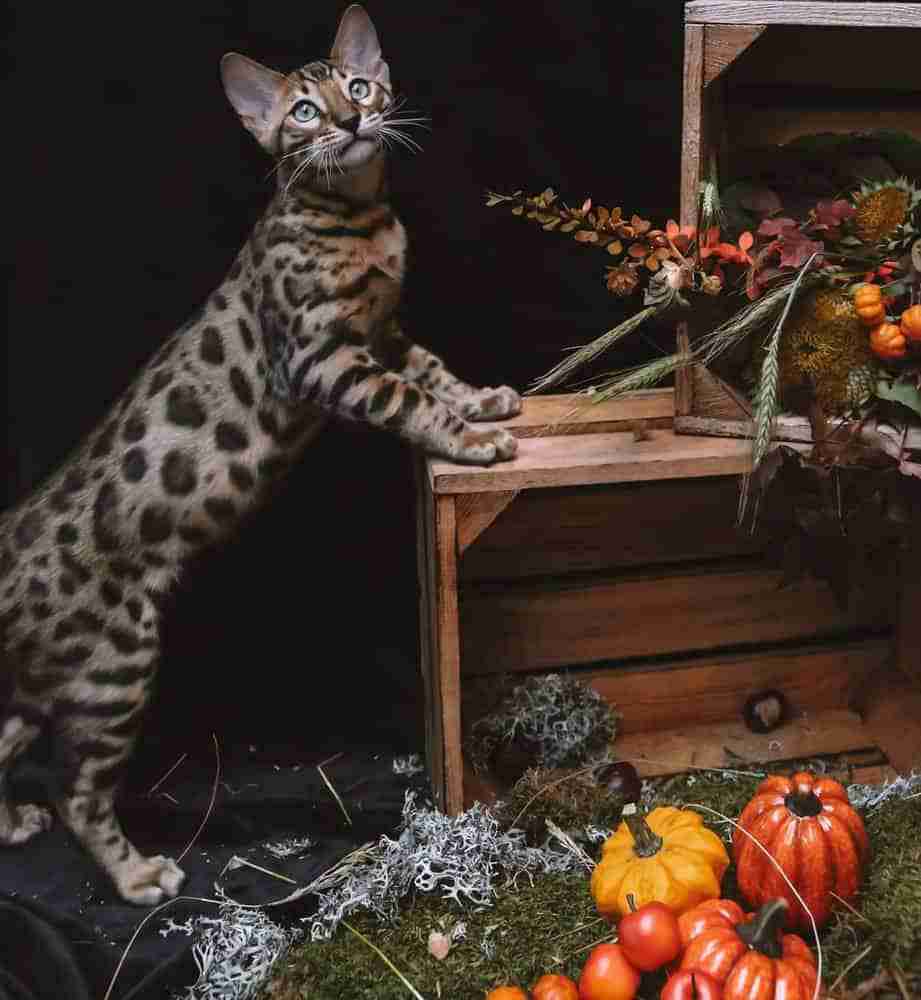
Care
Bengal cats are happiest when they are given ample play space and opportunities for physical exercise. In that sense, they can be pretty high maintenance as they need many things to climb or jump onto and have a lot of things to do.
As a highly agile breed, they are given to exploring high points in your home and will be seen staring down at you from the top of tall pieces of furniture.
On that note, we recommend stocking up on 2-3 cat trees and distributing them around your living space (depending on the size of your home) for your cat to entertain themselves. It’s even better if you can provide your cat access to a yard or balcony.
Investing in a cat perch is also recommended. As creatures with a high prey drive, these cats are highly engaged when they can watch squirrels, birds, etc. So, give yours a specially designated space to do just that.
With Bengals, two cats are better than one. If you spend a lot of time away from your home, it’ll be a lifesaver to have another cat with whom they can play.
These guidelines for caring for these hybrid cats should not be taken lightly. They are a cat who, if not adequately stimulated, will become agitated and look for ways to expend energy. They get bored easily and might become destructive if they feel under-stimulated.
So, don’t be angry if your under-stimulated cat gets into the trash or breaks items in your home.
That said, even those who have been provided adequate sources of mental and physical engagement might knock things over and break them (remember, every cat is an individual!).
So don’t leave valuable, fragile items out in your home. Another issue to consider is the Bengal’s love of hiding things, so don’t leave your jewelry or other valuable shiny things outside for them to conceal.
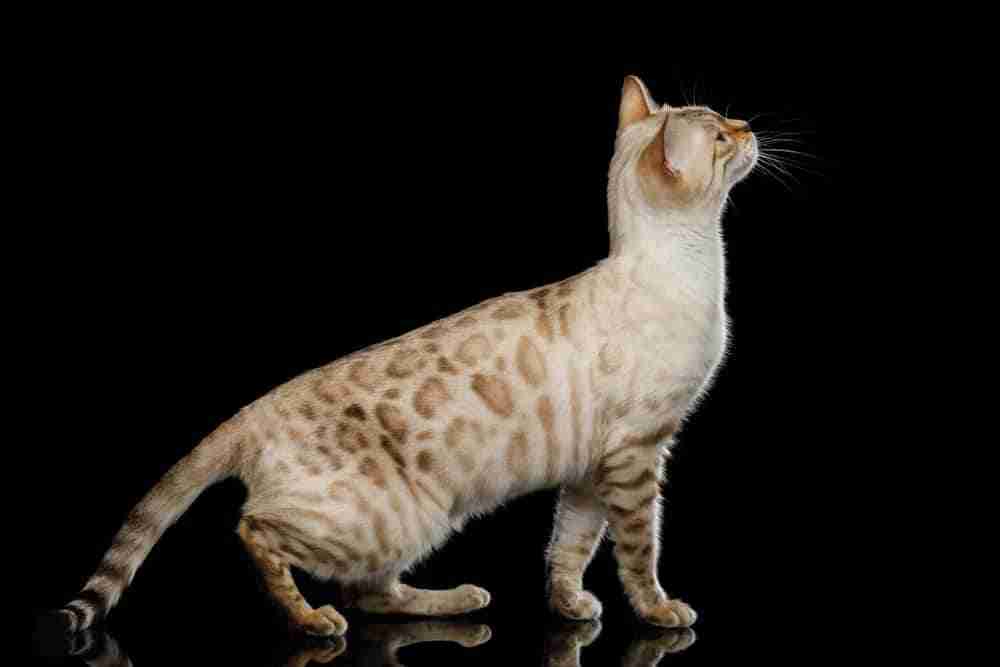
Diet
As you already know, the Asian leopard cat is one of the ancestors of the breed. Like wild breeds, these cats require a high-protein diet that can mimic their primal urge to consume small prey such as rodents, birds, lizards, and sometimes even insects.
This high protein diet is also important given the intense activity level of these cats.
That is why it’s essential to choose the right cat food, aiming for protein content of at least 60% and as high as 80%. Be mindful of not choosing commercial food that has the carrageenan additive known to cause cancer.
Want to give your cat homemade food? Even better. You can prepare food for your cat using raw meat and organs, taurine, and fish oil. There are numerous tutorials online on how to do this, and it’s worth doing if you have the time.
Unlike most other breeds, Bengal cats don’t hesitate to drink water, but in case you face difficulties in this regard, we would recommend giving your cat canned wet food to make up for water loss.
Under no circumstances should you feed your cat any of the following items: Avocado, chocolate, raw eggs, bones, yeast dough, or anything with artificial sweeteners.
Health Issues And Lifespan
The breed is relatively healthy compared to other breeds, and they tend to live from 9 to 15 years. Bengal cats aren’t immune to diseases, and in fact, 3 diseases are most commonly seen in these cats. Let’s have a closer look at each kind.
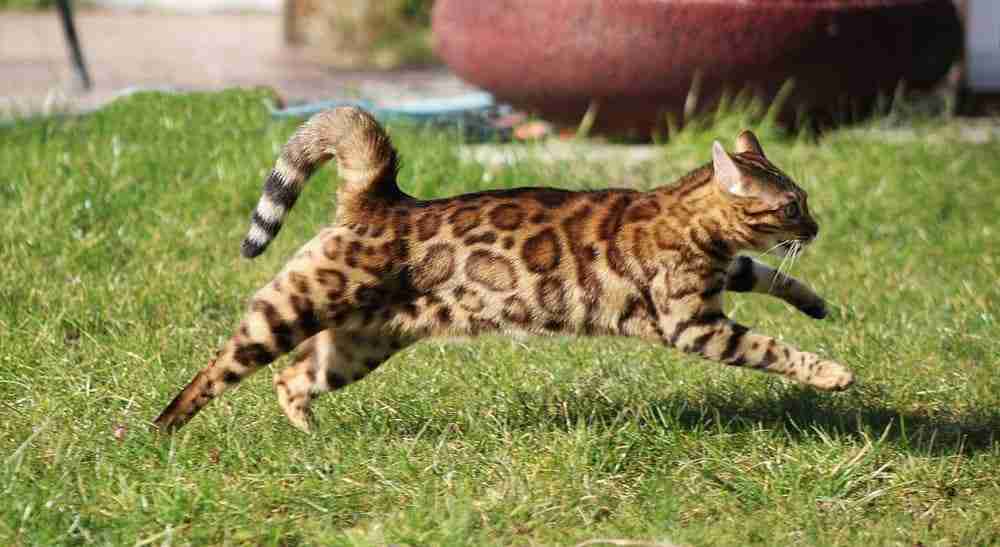
Heart Disease
These cats are susceptible to a heart condition called hypertrophic cardiomyopathy. This condition causes thickening of the heart muscle, especially if the cat is older. The result is usually congestive heart failure or blood clots.
Unfortunately, even some of the healthiest Bengals might develop heart disease. So, remember always to provide yours with a balanced and healthy diet.
Eye Disease
Progressive retinal atrophy is a form of eye disease that these cats are susceptible to, which might lead to blindness through deterioration of the retina. Bengals whose parents had progressive retinal atrophy are more likely to develop it, meaning it’s a genetic disease.
As such, make sure to ask your breeder to show you a certificate of clean health of your cat’s parents.
Anesthetic Allergies
Anesthetics can be pretty harmful to these cats. If your cat is being spayed or neutered, for example, ask your veterinarian to monitor your Bengal for signs of an allergic reaction closely. If undetected and/or untreated, this might lead to a fatal cardiac arrest.
Full/Partial Lameness
There is a chance of patellar luxation in older Bengals: the displacement (or luxation) of a kneecap. If you notice a skip in your cat’s step, notice that they have difficulty in jumping, or observe that they are attempting to run on three legs, they might have a luxated patella.
This condition is also called intermittent (on and off) lameness. The treatment for patellar luxation can be medical management and, in severe cases, surgery.
Hip Displacement
Hip dysplasia is the term given to the condition in which a cat’s hip socket does not adequately cover its upper thigh’s ball portion, causing dislocation. Your Bengal might suffer from pain, stiffness, and inflammation with hip dysplasia.
It might be hip dysplasia if you notice limping or walking difficulties in your cat.
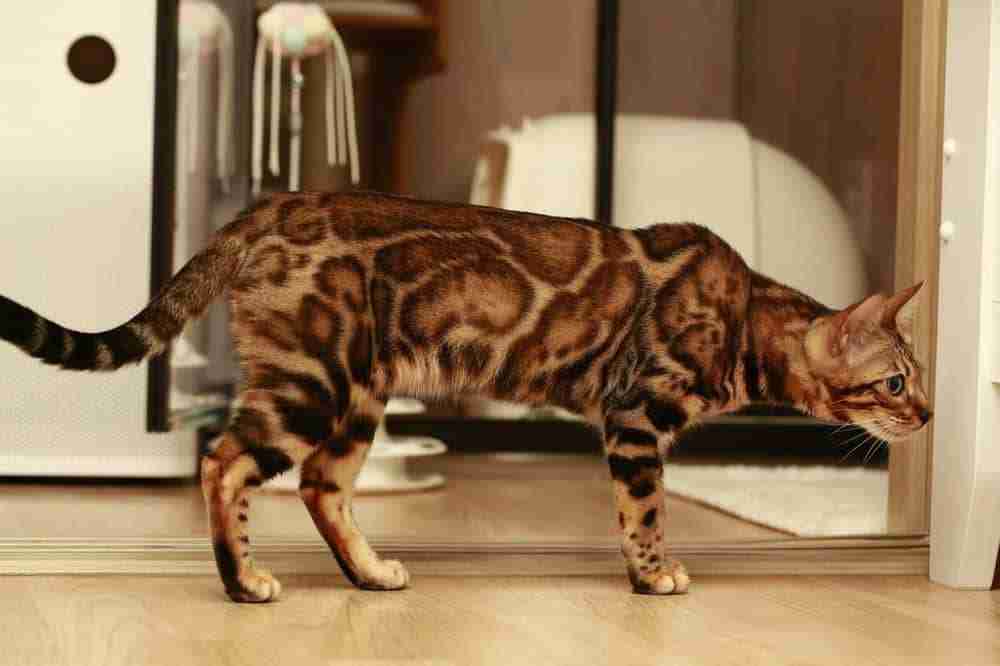
Price
Now for the moment of truth: how much do Bengal cats cost?
Kittens are usually more expensive than adult cats. On average, a kitten will cost around $1000.
Although the price can, of course, vary, we would advise you to be wary of kittens that cost below $500-$900 as the breeder might not be legitimate or give you a kitten who is likely to develop diseases in adulthood.
In regions where these hybrid cats are not easily found, the price of these cats is even higher. Also affecting the price is its vaccination, spay/neuter status, and whether it has been dewormed.
Additionally, you should gear up for high vet bills in the first year of your kitten’s life, along with, of course, annual vaccination renewals.
Final Words
These cats’ warm and affectionate personality, coupled with a gorgeous coat and high energy characteristics, definitely makes them a pet worth having. It’s no wonder that they are so widely sought or that they are sold for such a high price all around the world.
That said, these cats are by no means low-maintenance and will require much input from you in order to be healthy and happy. Due to their activity levels, Bengal cats aren’t well-suited to small spaces, and they love to run, jump and climb. Their high-protein diet should also be kept in mind.
If you can adequately provide all of this, you’re in for one of the most rewarding experiences of your life. Good luck!
